Copper (elemental symbol Cu) is the dominant portion of the Chilean economy, so we visited Chuquicamata mine in northern Chile to understand its production.
How did the Chilean government end up owning the mines?
The mines were initially developed by US and European engineers and in the case of Chuquicamata, the mine as an investment was bankrolled by the Guggenheim fund. By the late 1950’s the bulk of the Chilean copper mines were owned by two US companies (Anaconda Copper* and Kennecott Copper). *Anaconda Copper is now owned by BP, but does not extract any minerals; it exists to pay for previous environmental damage done in the US. The copper business is not clean. Back to our story: In 1969, the Chilean government bought 51% of the Chuquicamata mine in a “negotiated nationalization” to avoid conflict with the US. Anaconda and Kennecott copper agreed to a plan that allowed the Chilean government to buy the remaining 49% of the major mines, if certain financial targets were achieved by the Chileans.
When Socialist Allende took charge in 1971, he chose a more aggressive approach and took all the mines with zero compensation for the North American investors. He had huge Chilean support for this action and now on July 16 the Chileans celebrate National Dignity Day. The United States had a cold response to Chile’s actions. However, I can see the Chilean point of view during the 1970’s. Copper is their country’s natural advantage. As two visitors, it is tough to judge the ownership, as the Chilean’s did gain the territory via a war with the Peruvians and Bolivians. It was 80% of the economy in the 60’s. How can the Chileans expect to grow with this huge asset owned by foreign corporations at off-market rates.
During Pinochet’s rule, the Chileans did a reversal and encouraged outside investors. The “Codelco Law” of 1992 encouraged foreign direct investment into the copper mines and gave foreign investors protection from another round of nationalization. The Chileans have embraced the challenge to grow other industries besides copper, but the Chileans are still proud of the copper industry.
How do you mine copper?
The above photo is a portion of the Chuquicamata open mine. About 90% of what you see is rock that is being moved to gain access to the copper. This useless rock is discarded and creates many man-made hills distinguishable by their flat tops. If you squint at the photo you can see the huge trucks whose USD 40,000 tires are 15 feet high. The copper being mined lies along the same fault that runs through Los Angeles, the San Andreas Fault.
Copper ore must be beneficiated (concentrated) since the rock is only 1% copper. The first step is crushing the ore. We only saw the outside of a very large building with lots of pipes, conveyer belts and plenty of dust that was dedicated to the manly task of crushing rocks. Much like coffee, the iron ore is roasted to convert sulfides to oxides. After the crushing process, electrolysis raises the copper purity to 99%. There are two types of copper ore from Chuquicamata, sulfide ores and oxide ores. Oxide ores do not require roasting and thus are less costly to mine. I skipped a few steps since I doubt any of our readers plan on opening a copper mine. The skipped steps are floating the copper ore in a pool to sort the copper from the other content, drying the output and dousing it with Acid.
- 2 CuS + 3 O2 → 2 CuO + 2 SO2
- CuS + O2 → Cu + SO2
This is dirty work and there are many toxic by-products such as sulfuric acid and arsenic. At Chuquicamata the sulfuric acid is reused in the copper extraction process. They even have a bunch left over which they sell to other users. As for the arsenic, it is a sad story as the local water and the blood of the residents nearby have heightened levels of arsenic. The copper company guide did not highlight the arsenic issue on the tour.
- Two Fish Crew in front of mine
- Shovels loading the dump trucks
- Increasing copper density via suspension pools
- Can you see the tiny people?
The Town of Chuquicamata
When the Chuquicamata mine was founded almost 100 years ago it was more than a one company town. It was a town owned by the copper mine. The residents were all miners and their families. The company owned the land, houses, church, school and stores. As the environmental problems of living close to the mine became evident, the company decided everybody had to move. The miners were given new homes in the town of Calama. The company has decided to “freeze” the town in time. During our visit, a worker was watering the grass in the main square.
At the same time, Coldelco, the mine owners, have allowed for large portions of the town to be buried with the mine waste. A huge rock pile covers the hospital. Walking the town during the tour was eerie. I though I was in a Sci-Fi movie in which aliens had snatched all the humans. Thirty thousand people used to live in this town. Their new housing may not be as charming, but their blood stream will thank them for having fewer toxins.
- Gail in her mining outfit – no wonder her bags are so large
- Abandoned town is being consumed by mine waste
- Town’s old theatre
- Warning Sign
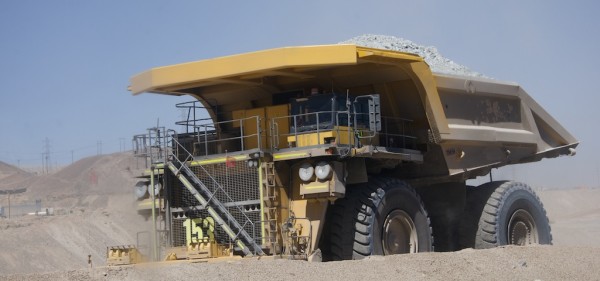
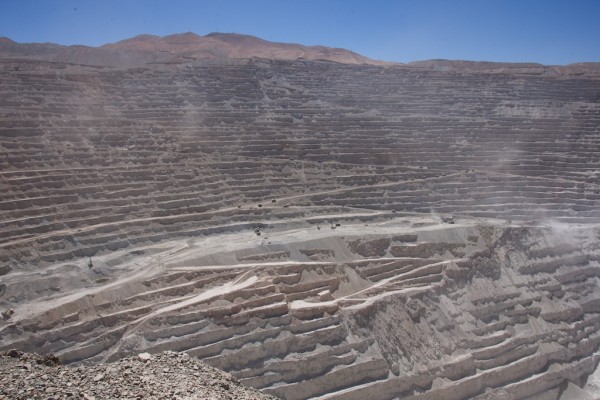
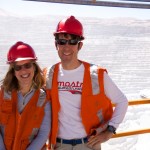
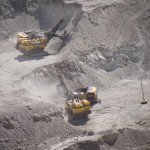
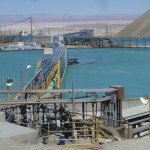


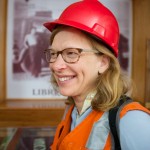

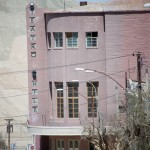
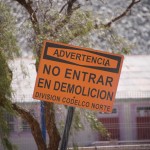


8 Responses to See You (Cu) Later